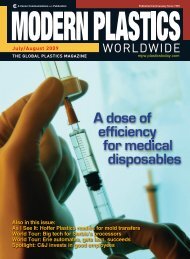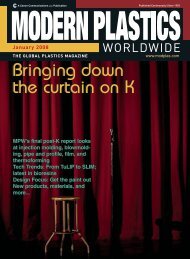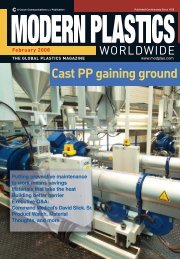amidiq - dae uptlax
amidiq - dae uptlax
amidiq - dae uptlax
You also want an ePaper? Increase the reach of your titles
YUMPU automatically turns print PDFs into web optimized ePapers that Google loves.
Abstract<br />
REVISTA MEXICANA DE INGENIERÍA QUÍMICA Vol. 6, No. 3 (2007) 337-345 AMIDIQ<br />
SWELLING KINETIC OF HYDROGELS FROM METHYL CELLULOSE AND<br />
POLY(ACRYLAMIDE)<br />
CINÉTICA DE HINCHAMIENTO DE HIDROGELES A PARTIR DE METIL<br />
CELULOSA Y POLI(ACRILAMIDA)<br />
N. Martínez-Vázquez 1 , R. del C. Antonio-Cruz 1 , A. Álvarez-Castillo 2 ,<br />
A. M. Mendoza-Martinez 1 and A. B. Morales-Cepeda 1*<br />
1 División de Estudios de Posgrado e Investigación del Instituto Tecnológico de Ciudad Madero, Juventino<br />
Rosas and Jesús Urueta S/N Col. Los Mangos, Cd. Madero Tamaulipas, México.<br />
2 Instituto Tecnológico de Zacatepec, Calzada Tecnológico 27, Zacatepec Morelos, México.<br />
* Corresponding author: E-mail: abmoralesc@prodigy.net.mx<br />
Phone and fax: (833) 2 15 85 44<br />
Received 17 th May 2007; Accepted 26 th October 2007<br />
The poly (acrylamide) (PAAm) and methyl cellulose (MC) hydrogels were prepared with a crosslinker using N, N’methylene<br />
bisacrylamide (NNMBA) and glutaraldehyde (GA). In order to do this, it was necessary to modify the<br />
percentages of catalyst (potassium persulfate, KPS) and crosslinker (NNMBA) for poly (acrylamide). To evaluate<br />
their maximum degree of swelling and to determine the swelling kinetics, the quantity of fluids absorbed by films<br />
was measured at different temperatures (20, 30, and 40°C) and pH’s (acidic, basic, and neutral). According to the<br />
results obtained from the experiment, the most suitable temperature and pH were 30°C and neutral, conditions<br />
under which the highest swelling values were obtained. In the kinetic study, during the first hours, a first order<br />
kinetic (Fick Model) was observed. The results were non–Fickian, revealing that the chain’s diffusion and<br />
relaxation processes occur at the same time during the absorption of the solution. For longer periods of time, with<br />
the exception of a 40 °C temperature (where the first order kinetic was identified), a second order kinetic was<br />
observed (Schott Model), indicating that there is no polymeric chain relaxation, but rather, contraction and collapse<br />
of the material. The relaxations of the polymer chain were observed after swelling via SEM pictures.<br />
Keywords: swelling kinetic, hydrogels, methyl cellulose, poly (acrylamide).<br />
Resumen<br />
Los hidrogeles de poli(acrilamida) (PAAm) y metil celulosa (MC) fueron preparados utilizando N, N-<br />
Metilenbisacrilamida (NNMBA) y glutaraldehído (GA). Para esto, fue necesario para modificar los porcentajes de<br />
catalizador (persulfato de potasio, KPS) y entrecruzante (NNMBA) para la poliacrilamida. Para evaluar el grado<br />
máximo de hinchamiento y determinar la cinética de hinchamiento, la cantidad de fluidos absorbidos por las<br />
películas fue medido a diferentes temperaturas (20, 30, y 40°C) y el pH (ácido, básico y neutro). De acuerdo a los<br />
resultados obtenidos de la experimentación, la temperatura y pH fue de 30ºC y pH neutro, condiciones en las cuales<br />
el grado de hinchamiento fue el máximo. En los estudios cinéticos, durante las primeras horas se observa un<br />
modelo cinético de primer orden (Modelo de Fick). Los resultados fueron del tipo no-Fickiano revelando que el<br />
proceso presenta difusión y relajación de las cadenas al mismo tiempo que ocurre la absorción de la solución. Para<br />
periodos largos de tiempo, con excepción de 40ºC (cinética de primer orden), el orden de la cinética fue de segundo<br />
orden (modelo de Schott), indicando que el polímero no sufre una relajación en la cadena, por el contrario presenta<br />
una contracción y colapso del material. La relajación de la cadena polimérica fue observado después del<br />
hinchamiento por SEM.<br />
Palabras clave: cinética de hinchamiento, hidrogeles, metilcelulosa, poli(acrilamida).<br />
1. Introduction<br />
Hydrogels are interesting materials that, due<br />
to their low toxicity and high biocompatibility<br />
properties, have become the center of attention for a<br />
large amount of research, mainly agricultural,<br />
biomedical, and pharmacobiological. The hydrogels<br />
are capable of collecting large quantities of water,<br />
maintaining their tridimensional structure, in<br />
quantities that depend on the hydrophilicity of the<br />
component polymers. This process is reversible, and<br />
dependent on the environmental conditions. The<br />
quantity of water that a macromolecular compound is<br />
capable of absorbing depends on the polarity of the<br />
Publicado por la Academia Mexicana de Investigación y Docencia en Ingeniería Química A.C.<br />
337









